Sensitivity Analysis of Ex-Vessel Corium Coolability Models in MAAP5 Code for the Prediction of Molten Corium–Concrete Interaction after a Severe Accident Scenario
Abstract
:1. Introduction
2. Description of Variable Parameters of MCCI Model in MAAP5 Code
3. Simulation of a Severe Accident in a Zion-like Nuclear Power Plant
3.1. Simulation of Base (Default) Case
3.2. Particle Bed Formation
3.3. Downward Heat Transfer Coefficient
3.4. Water Ingression Phenomenon
3.5. Melt Eruption Modeling Parameter
4. Sensitivity Analysis of the MCCI Modeling Parameters
4.1. Sensitivity Analysis Using Sobol′ Indices Method
4.2. Sensitivity Analysis Using Cotter Indices Method
- First run with all variables at their low levels (.
- runs at low levels, switching one variable at a time to its high level ().
- runs at high levels, switching one variable at a time to its low level ().
- Last run with all variables at their high levels .
5. Conclusions
Author Contributions
Funding
Data Availability Statement
Acknowledgments
Conflicts of Interest
References
- Amidu, M.A.; Olatubosun, S.A.; Ayodeji, A.; Addad, Y. Severe accident in high-power light water reactors: Mitigating strategies, assessment methods and research opportunities. Prog. Nucl. Energy 2022, 143, 104062. [Google Scholar] [CrossRef]
- Addad, Y.; Amidu, M.A. Numerical prediction of slug flow boiling heat transfer in the core-catcher cooling channel for severe accident mitigation in nuclear power plant. Nucl. Eng. Des. 2022, 393, 111796. [Google Scholar] [CrossRef]
- Amidu, M.A.; Addad, Y. The influence of the water ingression and melt eruption model on the MELCOR code prediction of molten corium-concrete interaction in the APR-1400 reactor cavity. Nucl. Eng. Technol. 2022, 54, 1508–1515. [Google Scholar] [CrossRef]
- Khurshid, I.; Afgan, I.; Amidu, M.A.; Yacine, A. Influence of corium temperature, concrete composition and water injection time on concrete ablation during MCCI: New insights. Prog. Nucl. Energy 2022, 144, 104102. [Google Scholar] [CrossRef]
- Corradini, M.; Reineke, H.H. A Review of the BETA Experimental Results and Code Comparison Calculations. Nucl. Sci. Eng. 1989, 102, 260–282. [Google Scholar] [CrossRef]
- Journeau, C.; Piluso, P.; Haquet, J.F.; Boccaccio, E.; Saldo, V.; Bonnet, J.M.; Brissonneau, L. Two-dimensional interaction of oxidic corium with concretes: The VULCANO VB test series. Ann. Nucl. Energy 2009, 36, 1597–1613. [Google Scholar] [CrossRef]
- Farmer, M.T.; Spencer, B.W.; Binder, J.L.; Hill, D.J. Status and Future Direction of the Melt Attack and Coolability Experiments (MACE) Program at Argonne National Laboratory; CONE-9; Argonne National Lab. (ANL): Argonne, IL, USA, 2001. [Google Scholar]
- Farmer, M.T.; Lomperski, S.; Kilsdonk, D.J.; Aeschlimann, R.W.; Basu, S. OECD MCCI 2-D Core Concrete Interaction (CCI) Tests: CCI-2 Test Data Report-Thermalhydraulic Results, Rev. 0 October 15, 2004; Argonne National Lab. (ANL): Argonne, IL, USA, 2011. [Google Scholar] [CrossRef] [Green Version]
- Bonnet, J.M.; Cranga, M.; Vola, D.; Marchetto, C.; Kissane, M.; Robledo, F.; Zhou, Q. State-of-the-Art Report on Molten Corium Concrete Interaction and Ex-Vessel Molten Core Coolability; Nuclear Energy Agency of the OECD (NEA): Paris, France, 2017. [Google Scholar]
- Copus, E.R.; Bradley, D.R. Interaction of Hot Solid, Core Debris with Concrete; Sandia National Labs.: Albuquerque, NM, USA, 1984; Available online: https://inis.iaea.org/search/search.aspx?orig_q=RN:18050559 (accessed on 23 June 2022).
- Shin, K.Y.; Kim, S.B.; Kim, J.H.; Chung, M.; Jung, P.S. Thermo-physical properties and transient heat transfer of concrete at elevated temperatures. Nucl. Eng. Des. 2002, 212, 233–241. [Google Scholar] [CrossRef] [Green Version]
- Sevón, T.; Kinnunen, T.; Virta, J.; Holmström, S.; Kekki, T.; Lindholm, I. HECLA experiments on interaction between metallic melt and hematite-containing concrete. Nucl. Eng. Des. 2010, 240, 3586–3593. [Google Scholar] [CrossRef]
- Sevón, T. A MELCOR model of Fukushima Daiichi Unit 1 accident. Ann. Nucl. Energy 2015, 85, 1–11. [Google Scholar] [CrossRef]
- Farmer, M.T. The CORQUENCH Code for Modeling of Ex-Vessel Corium Coolability under Top FLooding Conditions; Argonne National Lab. (ANL): Argonne, IL, USA, 2018. [Google Scholar] [CrossRef]
- Chatelard, P.; Reinke, N.; Arndt, S.; Belon, S.; Cantrel, L.; Carenini, L.; Piar, L. ASTEC V2 severe accident integral code main features, current V2.0 modelling status, perspectives. Nucl. Eng. Des. 2014, 272, 119–135. [Google Scholar] [CrossRef]
- Xu, Z.; Zhang, Y.; Lin, B.; Luo, S.; Zhou, Y.; Su, G.H.; Qiu, S. Development and application of MOQUICO code to study molten corium-concrete interaction. Ann. Nucl. Energy 2020, 144, 107597. [Google Scholar] [CrossRef]
- Sakai, N.; Horie, H.; Yanagisawa, H.; Fujii, T.; Mizokami, S.; Okamoto, K. Validation of MAAP model enhancement for Fukushima Dai-ichi accident analysis with Phenomena Identification and Ranking Table (PIRT). J. Nucl. Sci. Technol. 2014, 51, 951–963. [Google Scholar] [CrossRef] [Green Version]
- Hu, L.; Jeff, G. Transmittal Document for MAAP5 Code Revision MAAP 5.05; EPRI: Palo Alto, CA, USA, 2019. [Google Scholar]
- Cho, S.M.; Shin, S.W.; Oh, H.G. Sensitivity Analysis for MCCI and Corium Coolability Models in MAAP5. In Proceedings of the Transactions of the Korean Nuclear Society Virtual Autumn Meeting, Goyang, Korea, 21–22 October 2021. [Google Scholar]
- Alraisi, A.; Yi, Y.; Lee, S.; Alameri, S.A.; Qasem, M.; Paik, C.Y.; Jang, C. Effects of ATF cladding properties on PWR responses to an SBO accident: A sensitivity analysis. Ann. Nucl. Energy 2022, 165, 108784. [Google Scholar] [CrossRef]
- Amidu, M.A.; Alrahmani, M.A.; Addad, Y.; Khurshid, I.; Afgan, I. The impact of water ingression and melt eruption model on the prediction of molten corium-concrete interact using MELCOR code. In Proceedings of the 19th International Topical Meeting on Nuclear Reactor Thermal Hydraulics (NURETH-19), Brussels, Belgium, 6–11 March 2022; pp. 1–10. [Google Scholar]
- Sobol, I.M. Sensitivity estimates for nonlinear mathematical models. Math. Model. Civ. Eng. 1993, 1, 407–414. [Google Scholar]
- Homma, T.; Saltelli, A. Importance measures in global sensitivity analysis of nonlinear models. Reliab. Eng. Syst. Saf. 1996, 52, 1–17. [Google Scholar] [CrossRef]
- Janon, A.; Klein, T.; Lagnoux, A.; Nodet, M.; Prieur, C. Asymptotic normality and efficiency of two Sobol index estimators. ESAIM Probab. Stat. 2014, 18, 342–364. [Google Scholar] [CrossRef] [Green Version]
- Marelli, S.; Sudret, B. UQLAB: A framework for Uncertainty Quantification in MATLAB. In Proceedings of the 2nd International Conference on Vulnerability and Risk Analysis and Management (ICVRAM 2014), Liverpool, UK, 13–16 July 2014; pp. 2554–2563. [Google Scholar]
- Cotter, S.C. A screening design for factorial experiments with interactions. Biometrika 1979, 66, 317–320. [Google Scholar] [CrossRef]



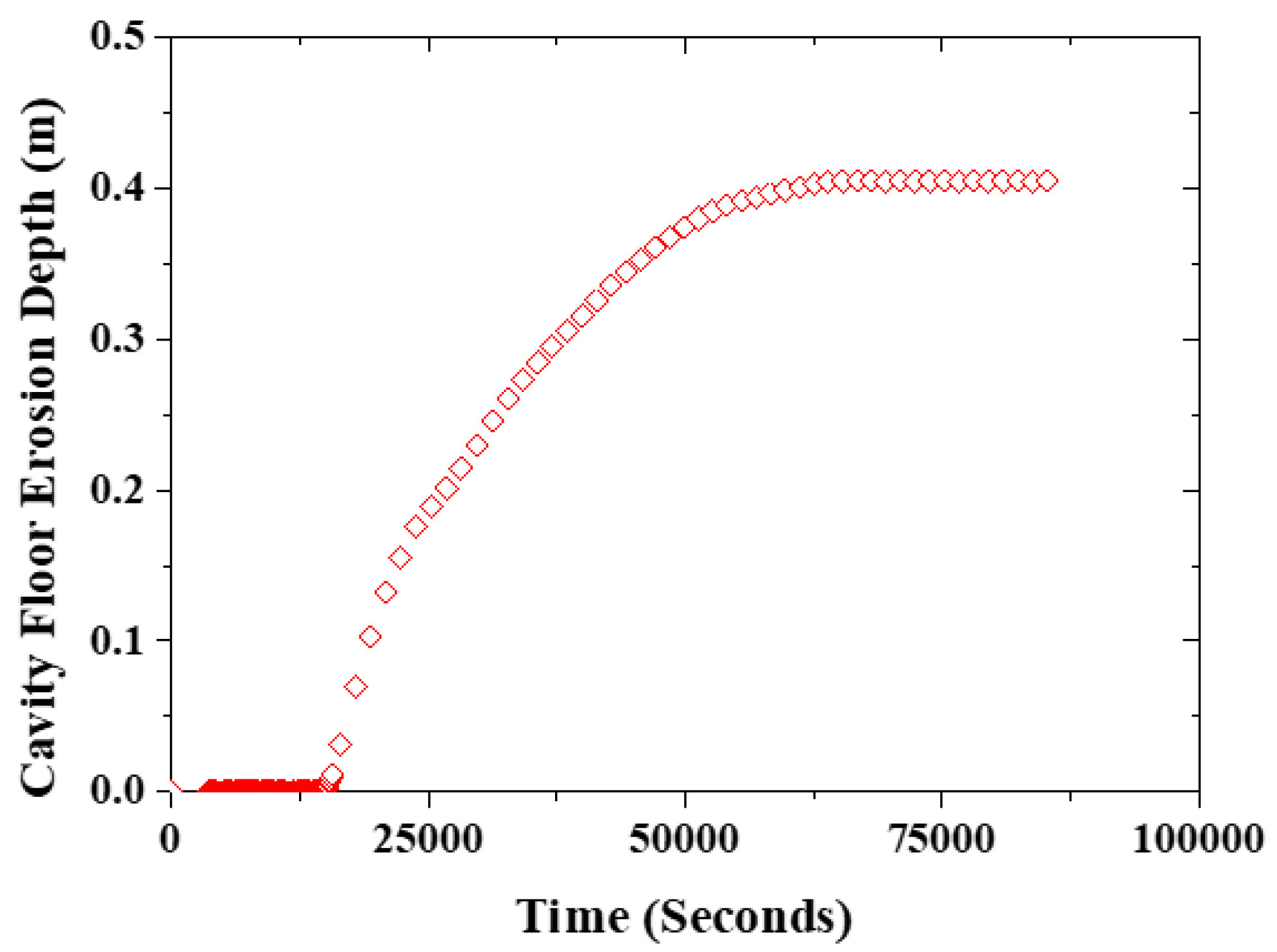

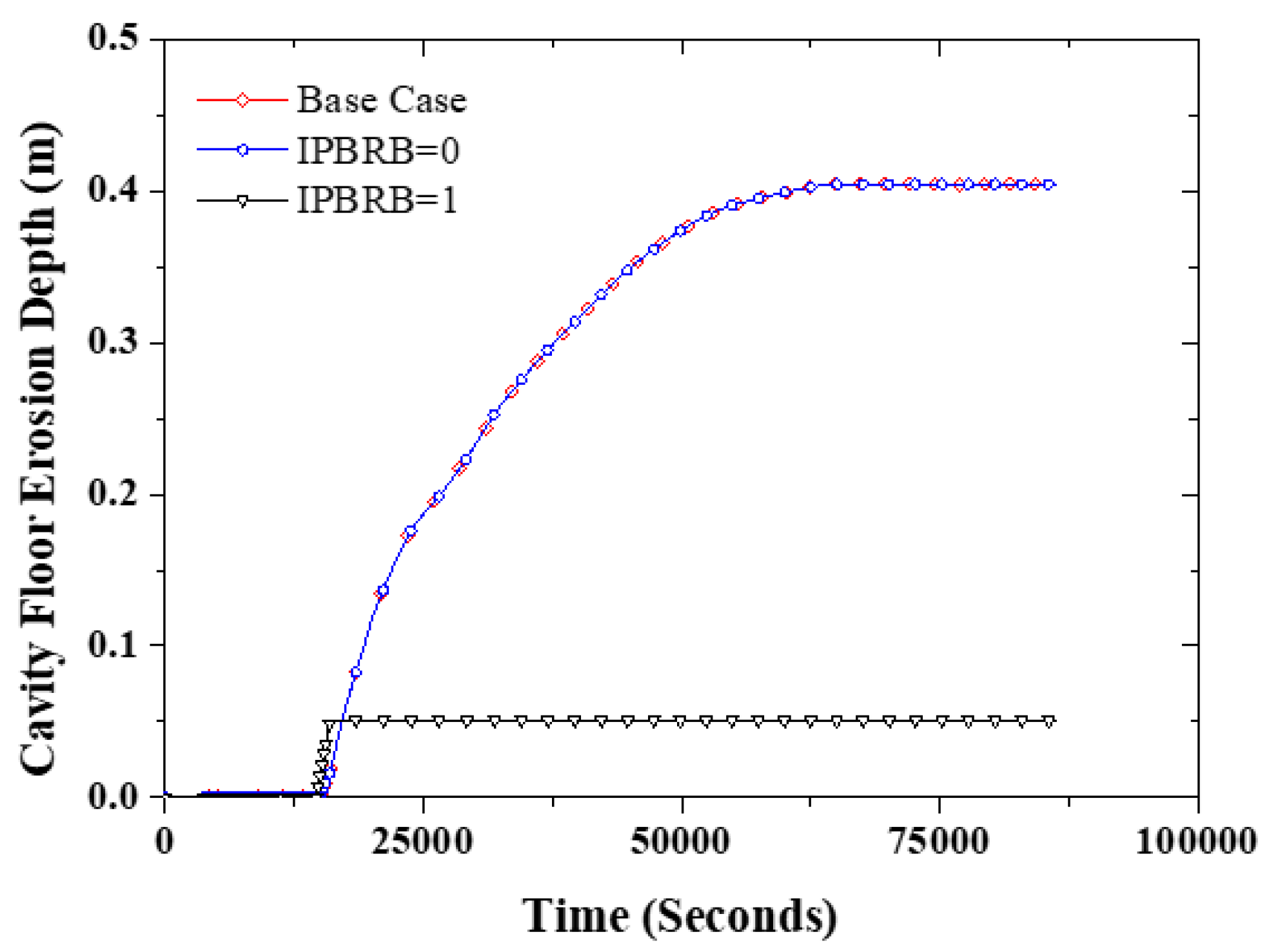

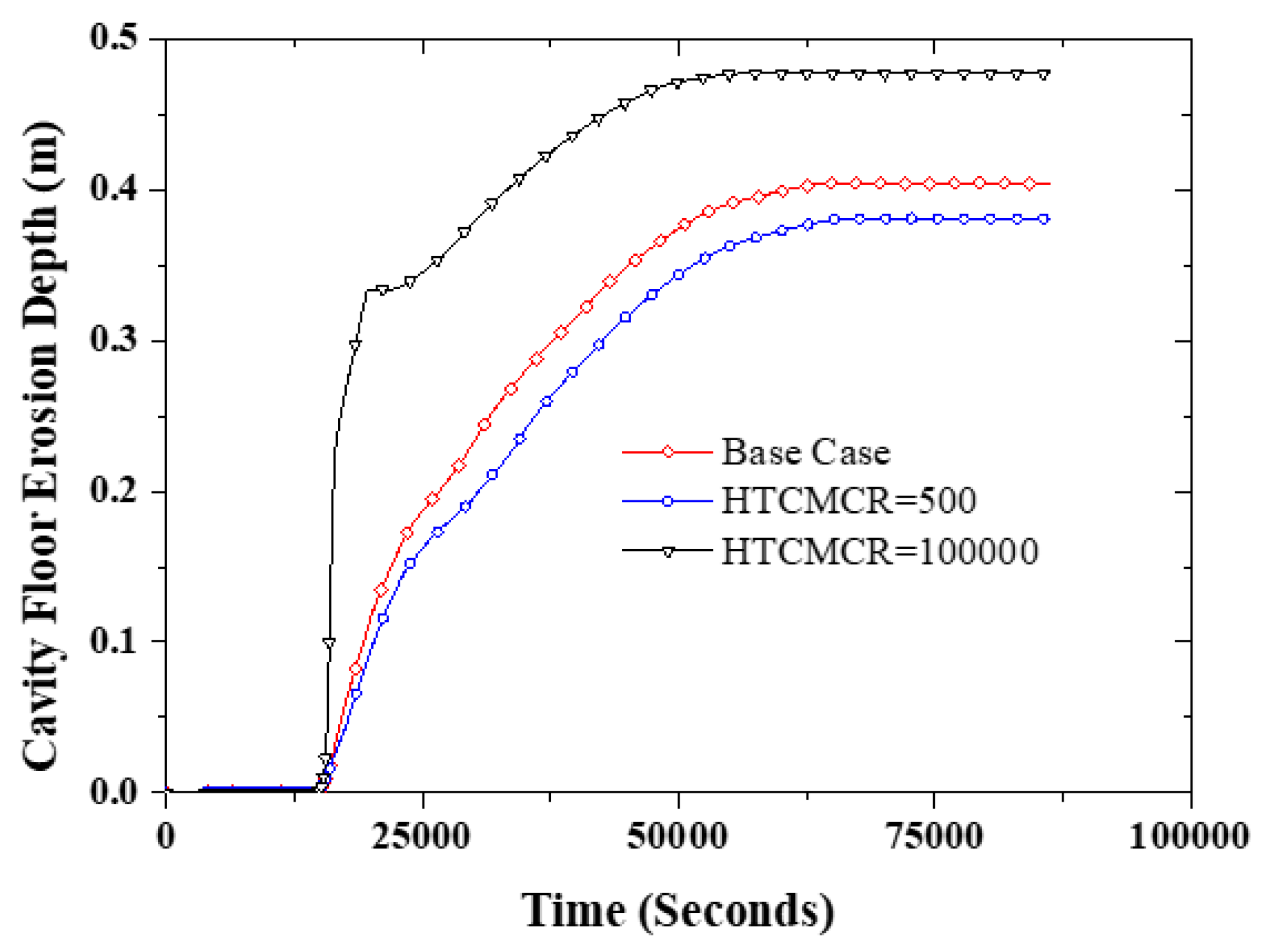
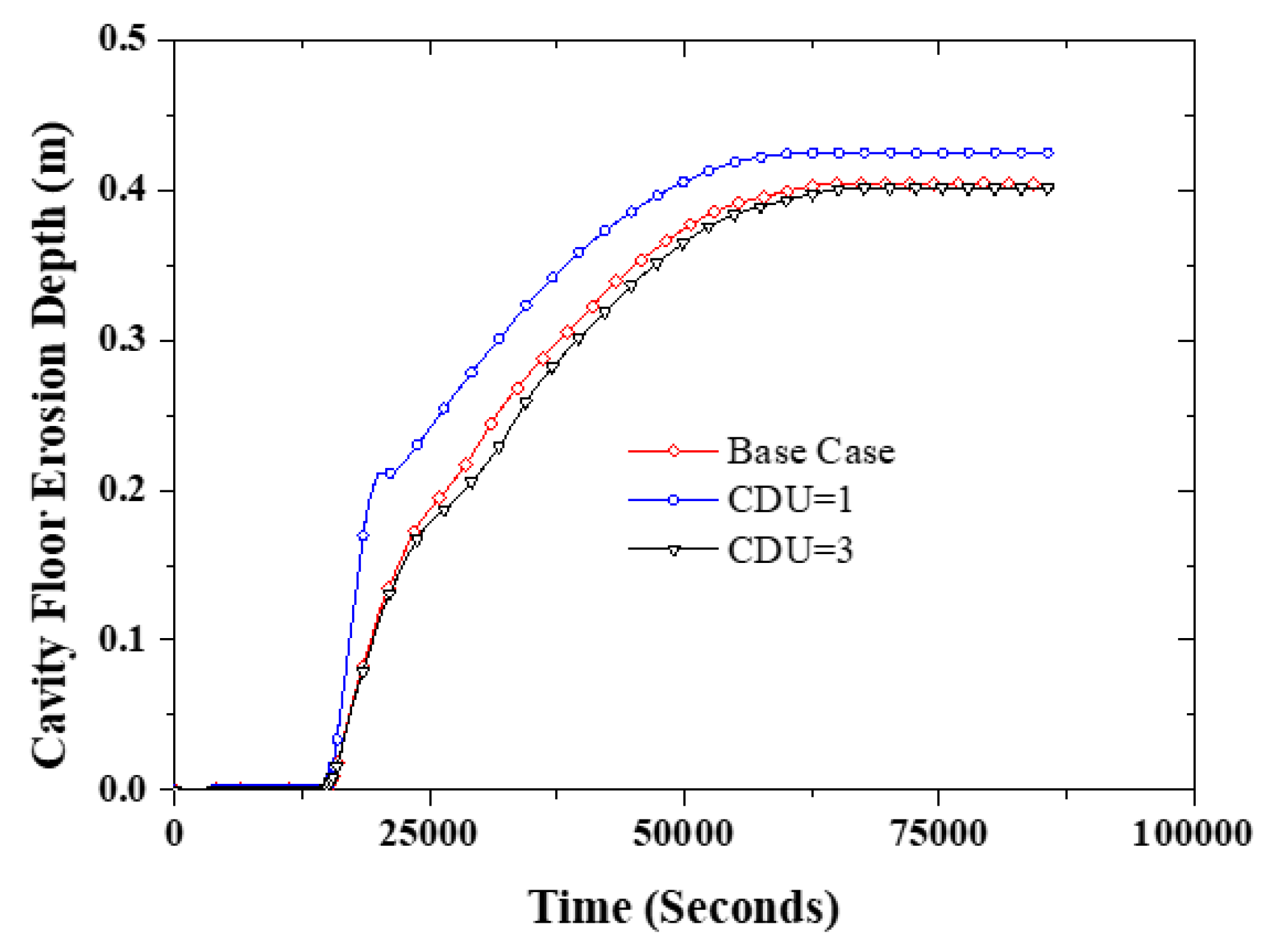
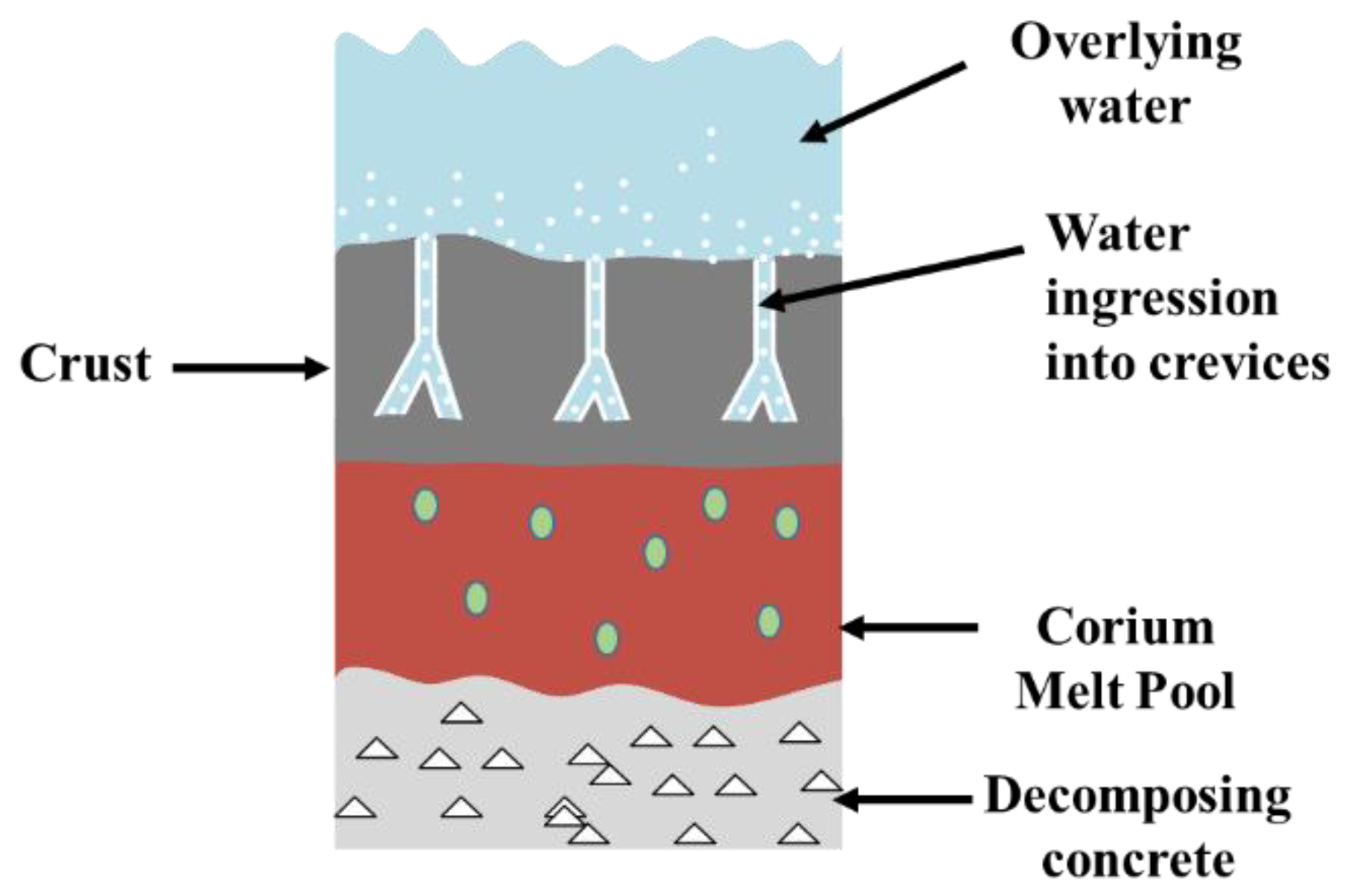
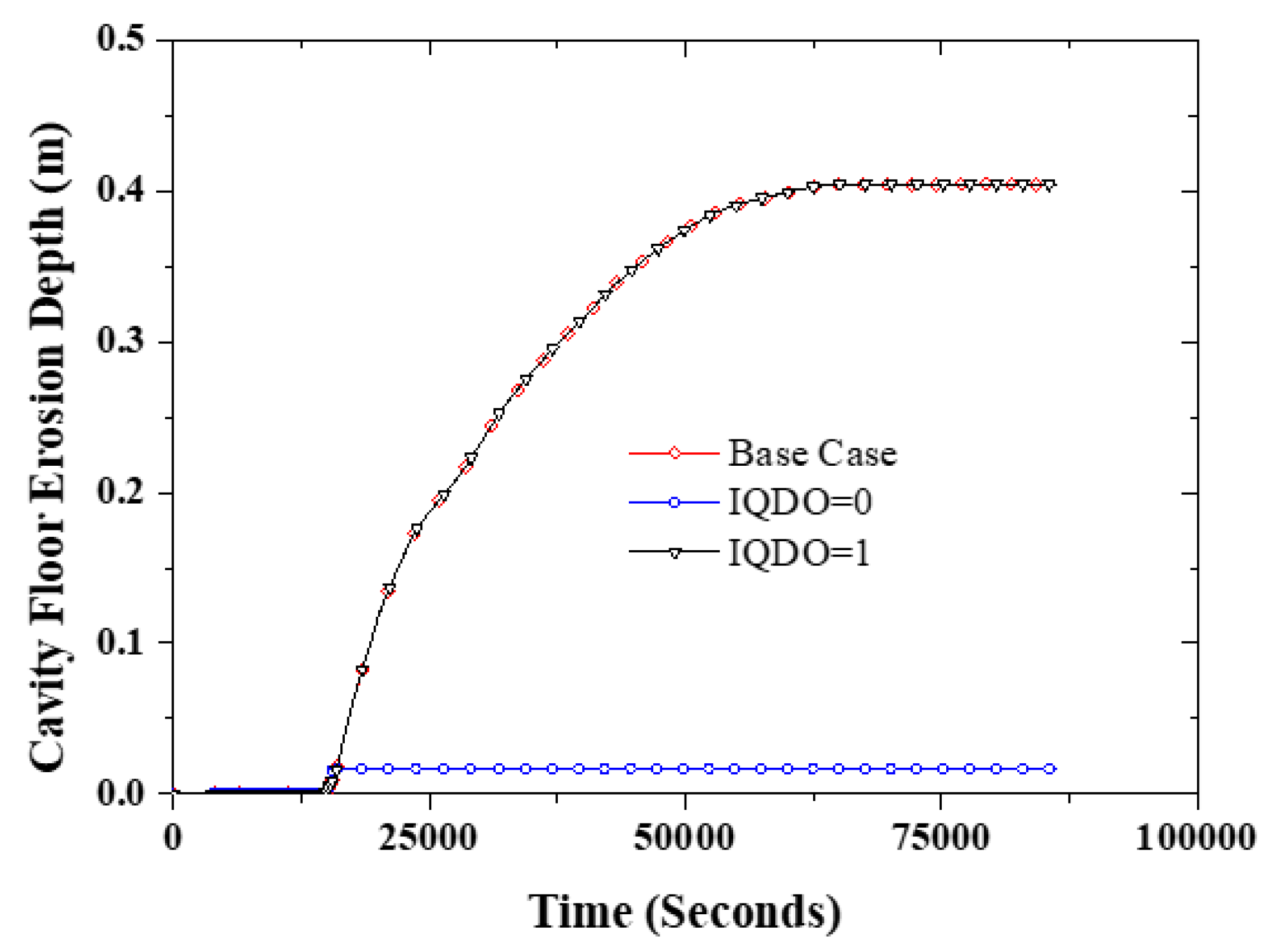

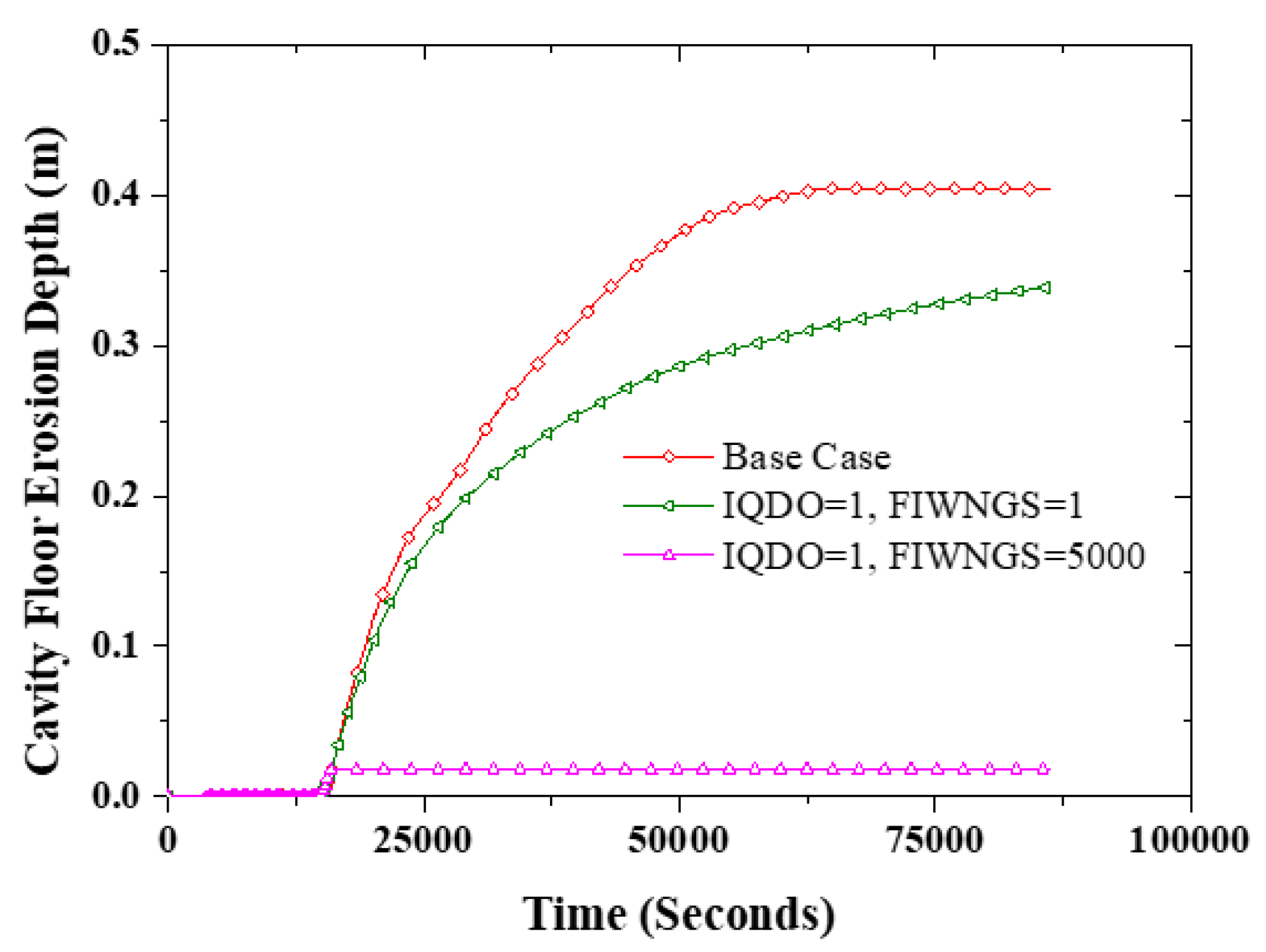
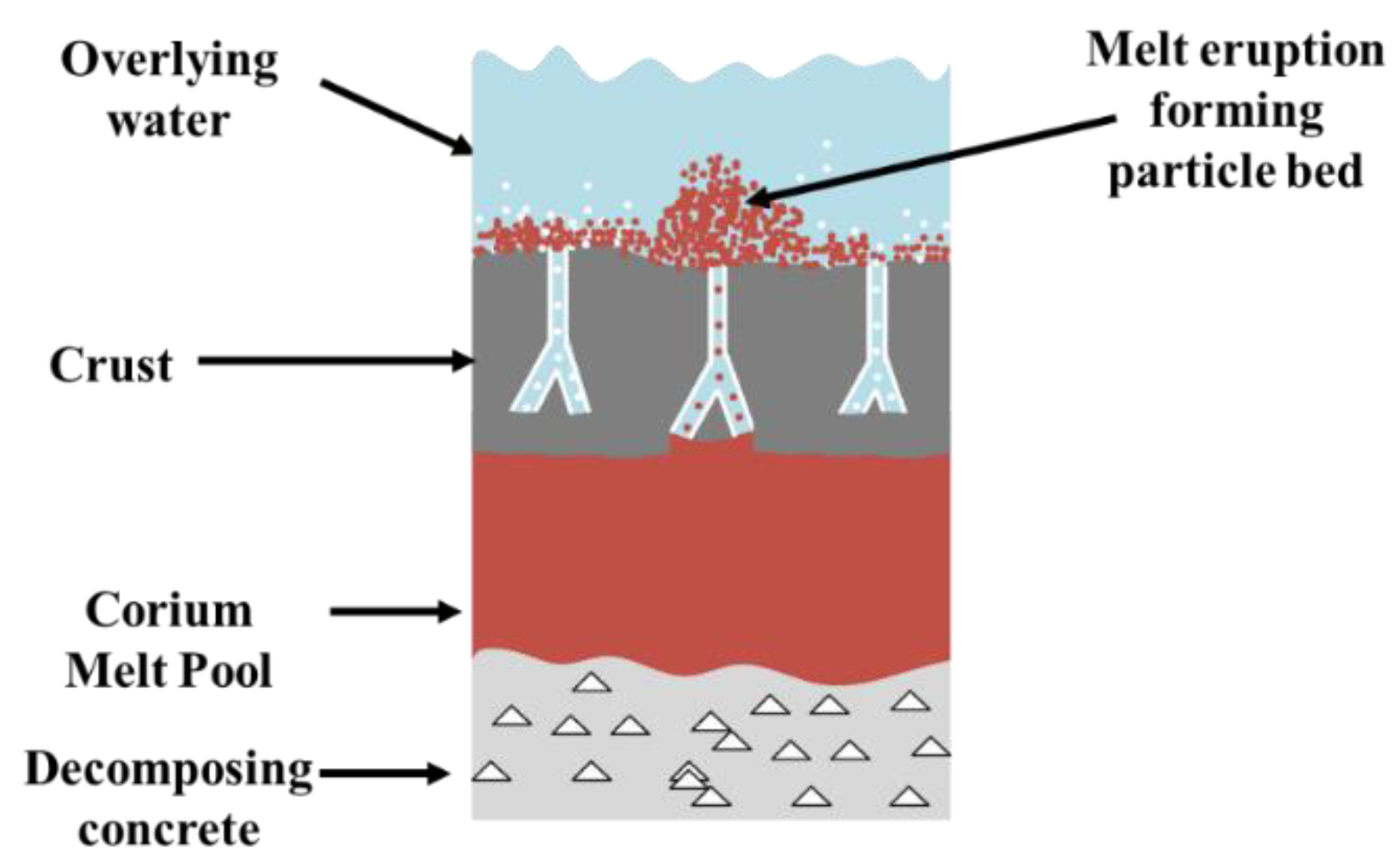
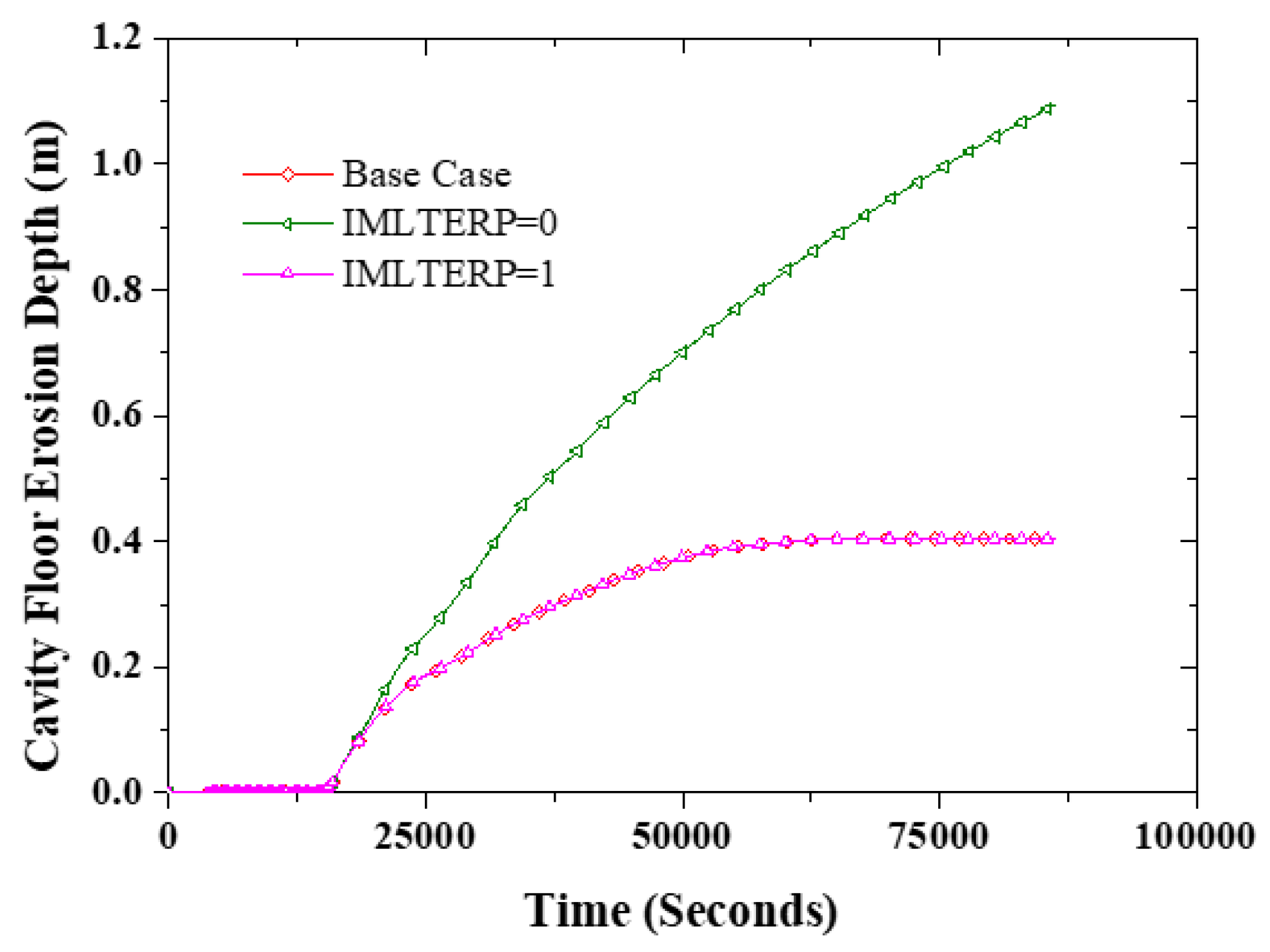
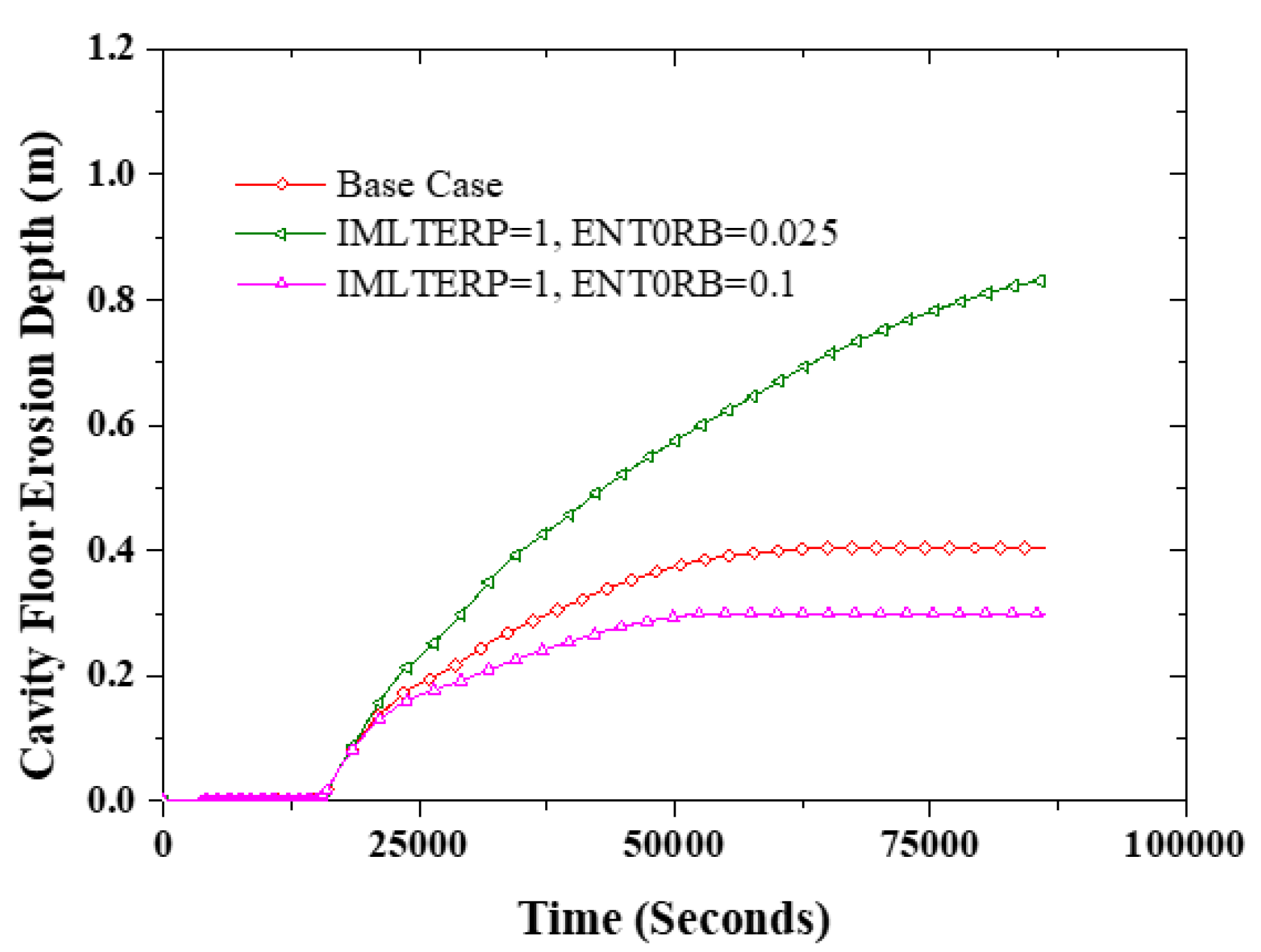
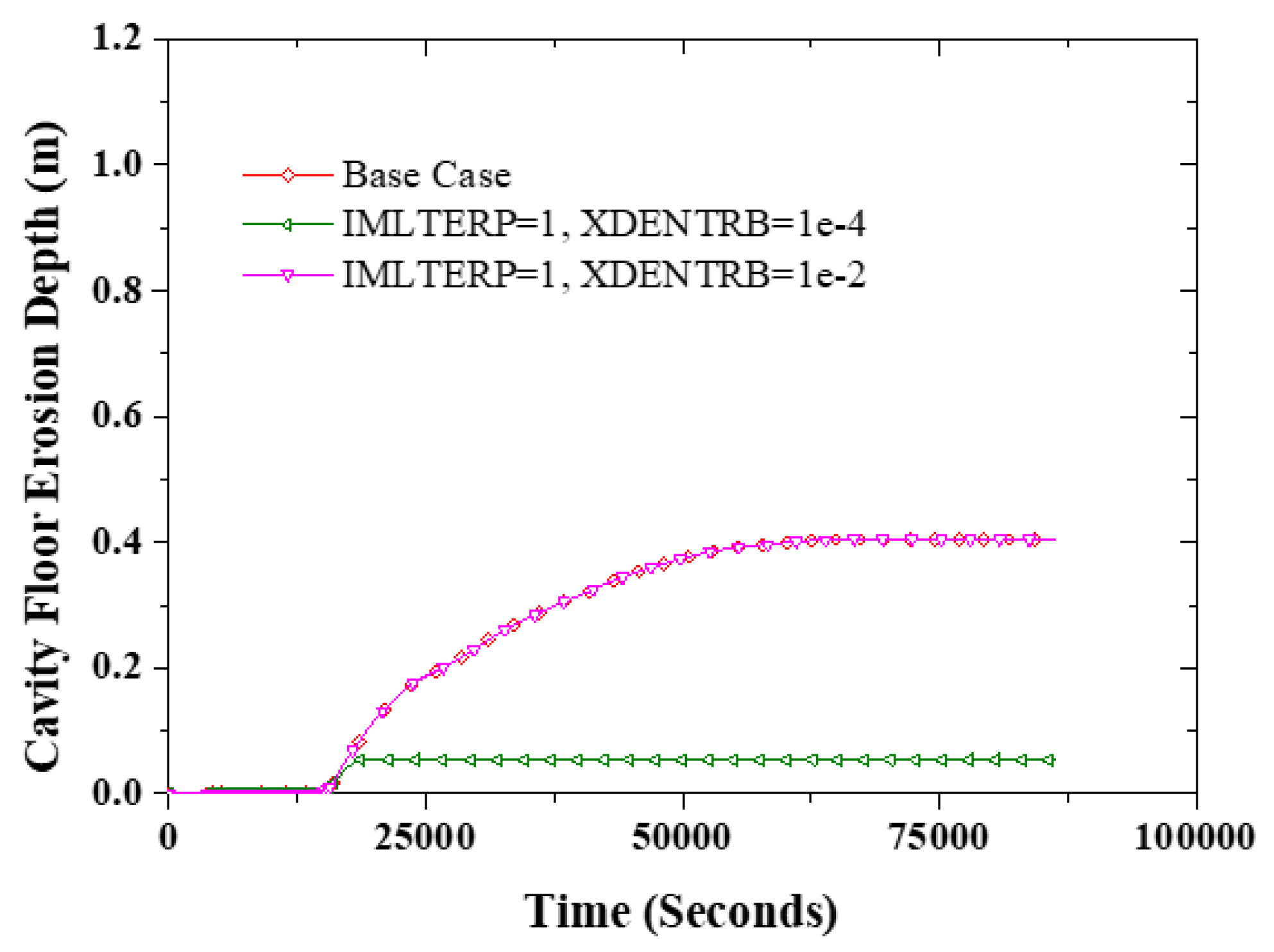

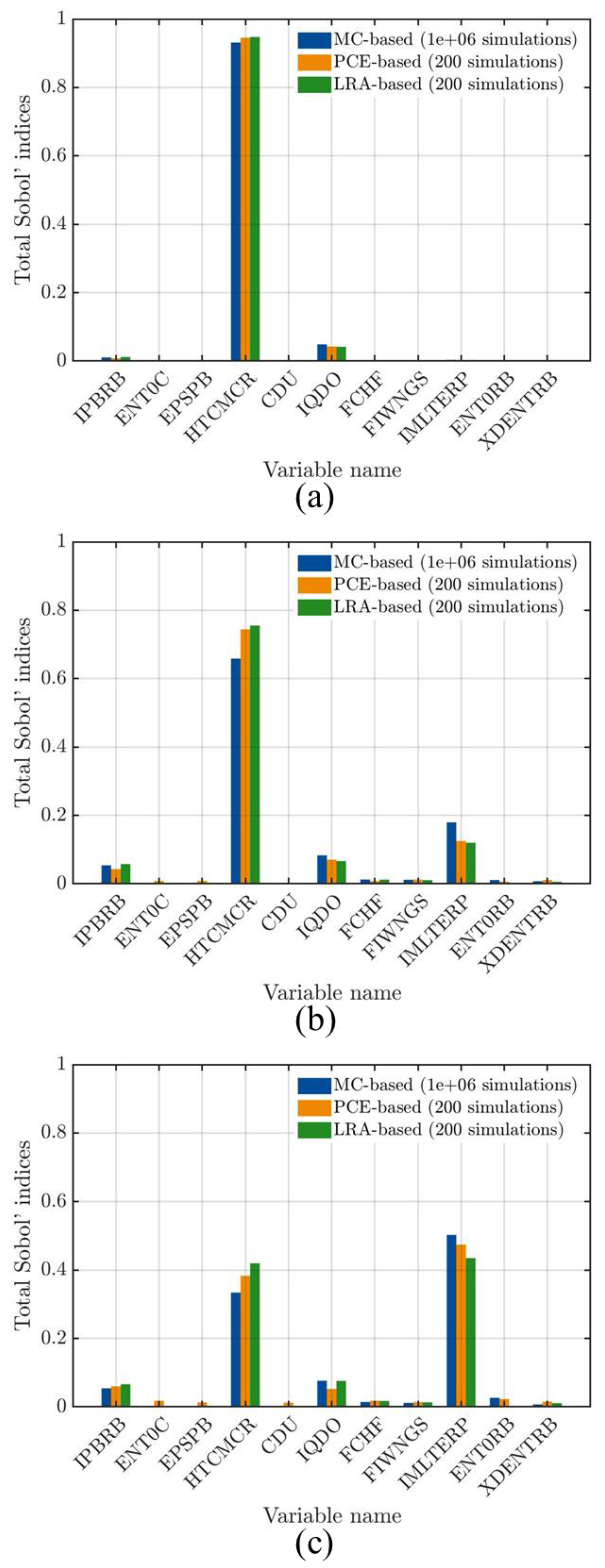
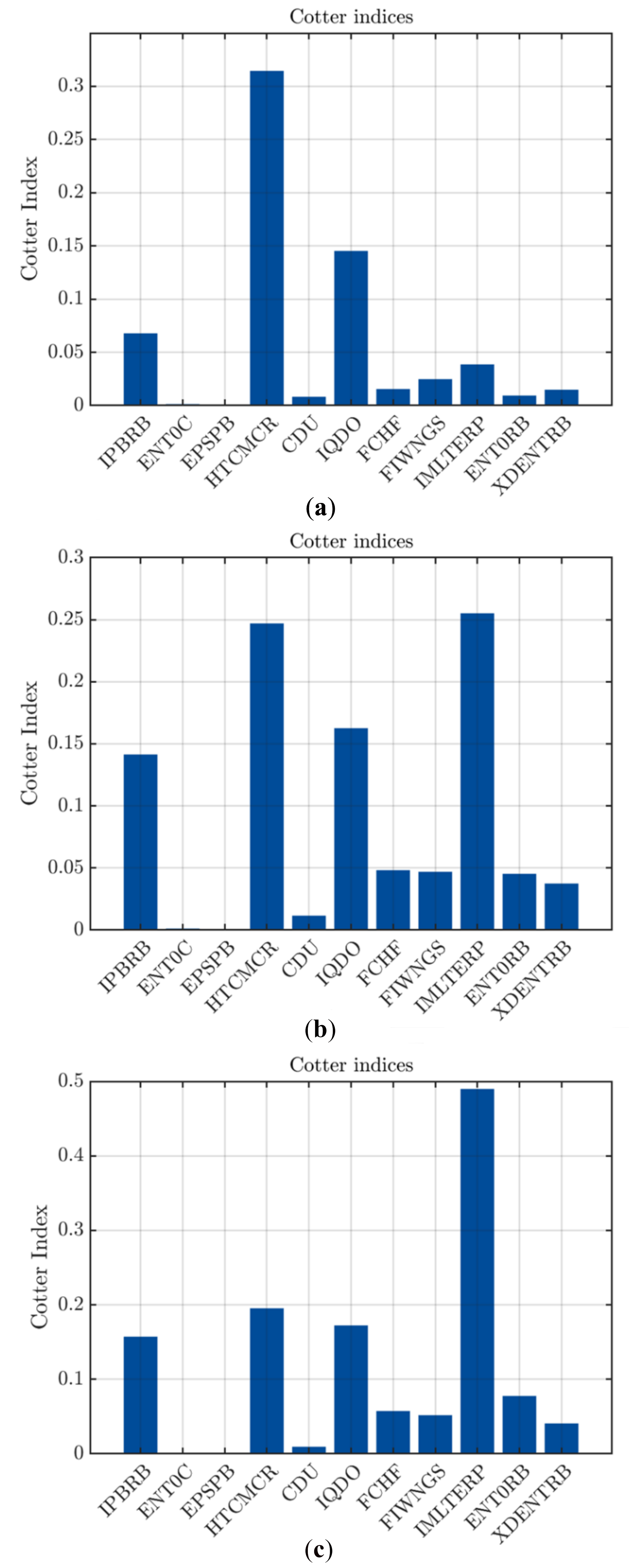
| Category | Parameter Name | Description | Lower Bound | Upper Bound | Default |
|---|---|---|---|---|---|
| Particle bed formation due to Fuel–Coolant Interaction | IPBRB | Flag turning ON (1) or OFF (0) particle bed formation due to FCI. | 0 | 1 | 0 |
| ENT0C | Ricou–Spalding jet entrainment coefficient. | 0.025 | 0.06 | 0.045 | |
| EPSPB | The porosity of the particle bed. | 0.26 | 0.53 | 0.4 | |
| Heat transfer coefficient in the MCCI | HTCMCR | Nominal downward heat transfer coefficient. | 500 W/m2K | 1 × 105 W/m2K | 3500 W/m2K |
| CDU | The exponent is used to calculate the downward and sideward heat transfer coefficients. | 1 | 3 | 2.75 | |
| Water Ingression | IQDO | To specify a method to calculate dry-out heat flux from the top of a contiguous corium pool to water (if = 0: parametric method; =1: mechanistic method). | 0 | 1 | 1 |
| FCHF | Parameter for heat flux from a contiguous corium pool to water when IQDO = 0. | 0.0036 | 0.3 | 0.1 | |
| FIWNGS | Specifies permeability of materials cracking due to thermal stress of quenching when IQDO = 1 | 1 | 5000 | 280 | |
| Melt Eruption | IMLTERP | Control flag to turn on melt eruption model | 0 | 1 | 1 |
| ENT0RB | The coefficient in Ricou–Spalding entrainment correlation, which controls the efficiency of melt eruption generating particles. | 0.025 | 0.1 | 0.08 | |
| XDENTRB | Average diameter of particles entrained by off-gas. | 1 × 10−4 m | 1 × 10−2 m | 4 × 10−3 m |
| Descriptions | Design Parameters |
|---|---|
| Reactor type | PWR Westinghouse design |
| Power | 3565 MW |
| Number of Steam Generator | 4-Loop |
| Steam Generator type | U-tube |
| Time (s) | Events |
|---|---|
| 0–3600 | Normal operation of the power plant |
| 3600 | LB-LOCA by cold leg double-ended break, which is instantly followed by high-pressure injection (HPI) as the core becomes uncovered |
| 3710 | Start of low-pressure injection (LPI) |
| 8847 | Reactor in-core instrument failed |
| 8930 | Maximum core temperature is exceeded and the core meltdown |
| 11,460 | Relocation of core material to the lower plenum started with the lower head pool |
| 14,694 | Reactor pressure vessel failed by plug melt of instrumentation tube and corium relocated to the flooded cavity |
| 84,740 | Containment failed due to over-pressurization |
Publisher’s Note: MDPI stays neutral with regard to jurisdictional claims in published maps and institutional affiliations. |
© 2022 by the authors. Licensee MDPI, Basel, Switzerland. This article is an open access article distributed under the terms and conditions of the Creative Commons Attribution (CC BY) license (https://creativecommons.org/licenses/by/4.0/).
Share and Cite
Amidu, M.A.; Addad, Y.; Hidaka, A. Sensitivity Analysis of Ex-Vessel Corium Coolability Models in MAAP5 Code for the Prediction of Molten Corium–Concrete Interaction after a Severe Accident Scenario. Energies 2022, 15, 5370. https://doi.org/10.3390/en15155370
Amidu MA, Addad Y, Hidaka A. Sensitivity Analysis of Ex-Vessel Corium Coolability Models in MAAP5 Code for the Prediction of Molten Corium–Concrete Interaction after a Severe Accident Scenario. Energies. 2022; 15(15):5370. https://doi.org/10.3390/en15155370
Chicago/Turabian StyleAmidu, Muritala Alade, Yacine Addad, and Akihide Hidaka. 2022. "Sensitivity Analysis of Ex-Vessel Corium Coolability Models in MAAP5 Code for the Prediction of Molten Corium–Concrete Interaction after a Severe Accident Scenario" Energies 15, no. 15: 5370. https://doi.org/10.3390/en15155370
APA StyleAmidu, M. A., Addad, Y., & Hidaka, A. (2022). Sensitivity Analysis of Ex-Vessel Corium Coolability Models in MAAP5 Code for the Prediction of Molten Corium–Concrete Interaction after a Severe Accident Scenario. Energies, 15(15), 5370. https://doi.org/10.3390/en15155370








